Five Producers Share Ideas That Have Made Their Farms and Ranches More Efficient
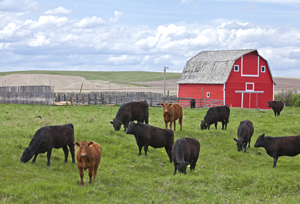
Editors note: This article is the second in a series featuring ideas from beef producers across the country. See the first: Eight beef producers share their recent changes
Fine-tuned management decisions with quick results and bigger management changes that may take a few years for benefits to materialize — these are ideas that Canadian beef producers are applying to their farming and ranching operations.
Good ideas can range from improving pasture watering systems and regularly testing winter feeds, to reducing costs during the fall/winter grazing period, to simple ideas that reduce the stress of calving out heifers, to more sweeping approaches on how to manage an intensive grazing system — all have a common objective to improve beef herd performance in sustainable farming systems.
Here are some ideas that Canadian beef producers have shared that help them produce more pounds of beef, reduce workload, improve overall efficiency and benefit cattle and the environment:
Sherri and Lynn Grant
Grant Ranch
Val Marie, SK
Managing calving heifers in remote locations
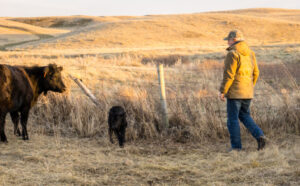
When it isn’t practical to bring the heifers to maternity pens during calving season, you bring the maternity pens to the heifers on pasture. That’s what the Grant Ranch in southern Saskatchewan has done for the past three calving seasons and it’s an idea they wish they’d thought of sooner.
The idea was born in the spring of 2016 says Sherri Grant who along with her husband Lynn and brother-in-law Dean ranch near Val Marie in southwest Saskatchewan, just north of the Montana border. “We were trying a different program in 2015 and had synchronized and A.I.’ed a fairly large group of heifers.” As the heifers started calving in early April 2016, the Grants were dealing with essentially a couple of good problems, calves were coming fast and furious. It was “raining” calves, but calving conditions also got a bit soggy as the clouds brought some much needed rain.
As Sherri Grant wrote on the ranch blog at the time “At the hub of this week though, it has been raining calves. We have averaged 12 calves per day in the last 10 days. We have a very busy maternity ward…Out of 230 heifers, we have had 50 per cent of the group calve with 117 calves.”
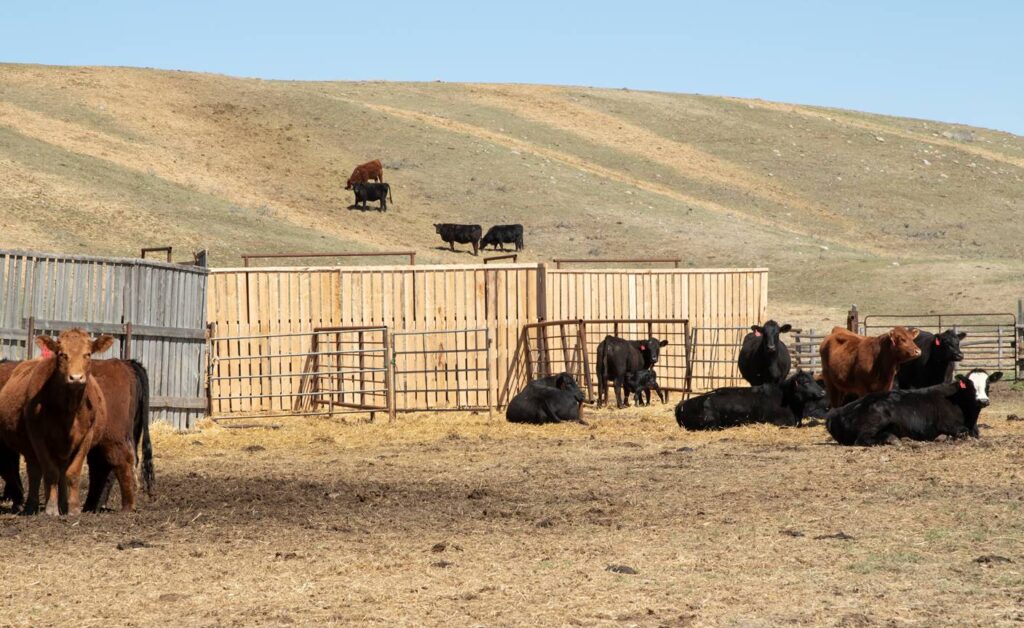
The heifer calving pasture is about 1½ miles from ranch headquarters, so a bit of travel is involved to check on calving progress, and if something did need calving assistance, it wasn’t easy to provide on pasture and took some organization if the heifer needed to be brought back to the home place. “The maternity pens were actually Dean’s idea,” says Sherri Grant. “ We have windbreaks out on pasture for the heifers, so he suggested we take portable corral panels out to the calving pasture and set up maternity pens against the windbreaks.” So the calving season of 2016 they set up two or three maternity pens against different sets of windbreaks over the heifer calving pasture. Using steel pipe corral panels for the sides as well as a gate panel, each pen was a 12’ x 24’ configuration and bedded with straw.
“And it worked really well,” says Grant. “It’s not that a lot of them needed assistance but it was just much easier to keep an eye on them particularly at night. And it becomes even more important if you have cool, wet rainy or snowy conditions at calving time and you want to make sure that a calf has nursed and is up and going.” She also notes that period from birth until the calf is up and nursing is also an important time for usually first-time mothers to “mother-up” and bond with and know their calves.
The corral panel pens are set up against the wooden windbreaks. While they are used during the day, especially if the heifer needs assistance, they are particularly of value as evening and nightfall sets in. If they see a heifer is getting close to calving they herd it into one of the maternity pens and can check on it later. “You can come back in a hour to check or just wait in the truck and the heifer is not going wander off on you,” says Grant. “When they are out on the large calving pasture and especially when it’s dark, they can be hard to find, or maybe you do find a heifer with a new calf, but then you might wonder is that her calf or did she steal a calf from someone else. So being able to move them into a maternity pen right on pasture, just reduces stress and provides peace of mind.” The first year, out of 117 head born during the first 10 days of the calving season, only seven per cent of heifers needed assistance at calving.
Once the heifer calves and the Grants have seen the calf up and nursing and looking vigorous, the pair is turned back out onto pasture. At the end of calving season, the corral panels are collected and used as needed during the grazing season. The pasture maternity pens worked so well the first year, the Grants have kept the system going each of the past couple seasons. They will have panel pens set up again for the 2019 calving season, even though heifer numbers are down to more usual 100-plus head this coming season. The main cow herd, ranging between 800 and 900 head, calves on open rolling pasture about 10 miles from the ranch headquarters. That herd is checked as well, but is pretty self-reliant and trouble free when delivering calves.
“Often invention is the mother of desperation,” Grant says jokingly. “That first year we had a larger number of calves than usual, the calves were coming fast and the weather really wasn’t co-operating so bringing maternity pens to the pasture really made it so much easier to manage.”
Jason Reid
Reid Ridge Farms
Thunder Bay, ON
Using corn residue, corn silage and corn grazing
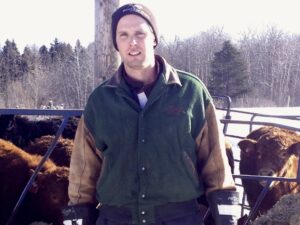
Filling that expensive November/December feeding gap — fall pasture has ended, but winter corn grazing hasn’t started — has led Jason Reid to consider a few options on his Northern Ontario beef and sheep operation.
The summer of 2018 he had planned to cut spring-seeded barley for silage in about mid-July and then re-seed the field with an oat/barley mix to provide late season grazing in November/December. However with a dry summer and insufficient rain in late July and August, he got the barley silage cut, but put the summer-seeding plan on hold. His next option was to work with a neighbour who harvested grain corn and put the cowherd on a field of corn stover and residue for late season feed.
“That late season period — November and December — can be our most expensive feeding period,” says Reid, who this year is running about 100 cow-calf pairs, backgrounding about 70 head and also runs a sheep flock of about 300 ewes. While he produces about 75 per cent of his own hay on 600 acres of deeded and rented land, he says he is fortunate to farm in an area where he can also buy mid-quality, beef-grade hay for winter feeding — the price is reasonable but it is still a cost. Whether it is his own or bought hay it has a cost. And he also has to consider equipment, time and labor while feeding hay during that period.
“So if we can find some sort of pasture for the November/December period it just saves on hay and feeding costs,” he says. “Most years being too dry isn’t a concern. It is more common that we are dealing with too much moisture. But the 2018 growing season was just about the opposite. We did get rain but it didn’t come exactly when we needed it.”
Reid and his wife Trudy, who moved from Northumberland County on the northern edge of Lake Ontario to Thunder Bay on the northern edge of Lake Superior in 2003, farm on the edge of the city. Along with their deeded farm base, they also rent mostly small-acreage parcels of land from some 26 landowners. Much of their land base is low lying “swampy” type ground that produces high volume, relatively low feed-quality reed canary grass. They’ve worked to improve pastures on their home base farm over the years.
“Part of the home farm used to be a sod farm at one time, so when we took over it had some of the poorest quality, compacted soil in the area,” says Reid. For a few years they grew turnips and forage radish on part of the depleted land to help open up the soil and bring it back into production. “The turnips and radish worked very well and provided excellent late fall/early winter grazing. We would also provide some reed canary hay and cattle did very well.” However, in more recent years Reid says it has become an increasingly difficult logistical challenge to get turnip and radish seed in the Thunder Bay area. He looked for a different option — corn fit the bill.
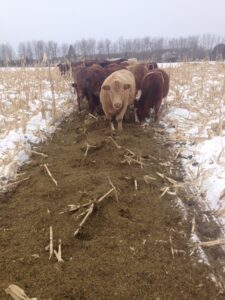
In the past few years he has grown about 45 acres of silage corn on the home farm. About 25 to 30 acres is cut for silage to feed to backgrounding calves and also as feed supplement with hay for the cowherd in the weeks prior to calving. The remaining 14 to 15 acres of corn was saved for winter grazing. Reid holds cattle off the area until early to mid-January to ensure ground is well frozen. To help balance the ration while grazing corn, Reid feeds cereal silage on alternate days. For example, using hot-wire fencing, cattle are limit- fed the standing corn and held on an area that should last four days; about half way through that period he will also feed grass silage on the grazed corn strips one day. On the fifth day the herd moves to a new area of standing corn. In 2017, when Reid was running about 37 head of cows, the 14 acres of grazing corn would provide about two months of winter grazing.
“In 2018 our cow herd increased to 100 head so we converted more acres of a large pasture on the home farm and grew more corn,” he says. Again about 25 to 30 acres was cut for silage, and he left another 25 acres to be used for corn grazing starting in January. This fall the cow herd will graze corn residue until early January, then move into the standing corn for winter grazing, until about three weeks before calving in late March/early April. “After the grazing corn they go on to full stored-feed — silage and hay— which carries them up to calving,” he says.
Miles Wowk
Wowk Ranches Ltd.
Beauvallon, AB
Improving the quantity and quality of both water and forages

On the Wowk ranch in northeastern Alberta several relatively minor-to-medium changes in production practices add up to make considerable improvements in overall beef herd performance, says Miles Wowk.
Changes in the pasture watering system, forage stand improvements and providing a balanced ration during winter feeding are some of the fine-tuning details they’ve addressed on the family-run Wowk Ranch Ltd. operation at Beauvallon, about half way between Vegreville and St. Paul. The Wowks run a 300 head cow-calf operation, along with about 80 head of horses.
As they follow a rotational grazing system on about 4000 acres of pasture, one improvement in recent years has been to provide cattle with water through solar powered, off-site water systems.
“For many years cattle watered directly out of dugouts and sloughs,” says Wowk. “But in the last few years we’ve converted to solar powered pumps that deliver water to troughs. Having clean, fresh water available to both cows and calves has made a huge difference in performance.”
Both the cows and calves prefer clean water, he says. Cows drink more, which he believes translates into more milk production. And more milk means improved rates of gain on calves. The calves also drink more water, which improves their growth as well. The portable solar powered systems are moved from pasture to pasture as cattle move through their grazing rotation.
And Wowk manages pastures to maintain a high legume content in a grass/legume forage blend. He’s developed a relatively low-cost system to renew alfalfa stands on an ongoing basis.
“About six years ago we started top dressing pastures with alfalfa seed and fertilizer and it’s made a tremendous difference in forage production,” he says.
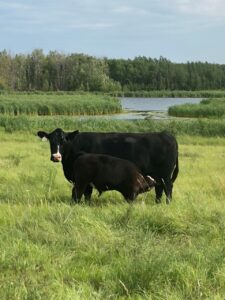
Grazing land on the ranch is divided into pastures and he treats about one-third of each pasture with the seed/fertilizer blend on a rotating basis. For example, on a 160-acre pasture he will treat about 50 acres in early spring with a broadcast application that includes about five to seven pounds of alfalfa seed along with about 40 pounds of actual N. He won’t be back to fertilize that same pasture for two years and then will treat a different 50-acre block. “We usually time the treatment for April when the snow is gone and yet there is good moisture in the soil surface,” he says. The 50-acre block is harrowed after the treatment. He’s applying the treatment on some part of the ranch every year.
“Some advisors told us we were wasting our time applying the fertilizer with alfalfa seed, but it makes a tremendous difference,” says Wowk. “I estimate the treatment is producing at least 20 per cent more forage with an excellent stand and excellent growth on the alfalfa.”
Improving the quantity and quality of both water and forages is an important part in improving overall herd performance and efficiency, says Wowk. Part of that efficiency has also been a change in the beef herd breeding program in recent years focusing on more moderate-size Angus breed genetics rather than Simmental genetics. “We have decreased the size of the cows in our herd but kept our weaning weights the same,” he says. “The size of our cows has dropped by around 30 per cent so that is our gain in our calf crop — 10-15 per cent because of fresh water and 15-20 per cent due to improved pasture.”

To keep pastures productive, Wowk also takes every opportunity to concentrate cattle on poorer ground during the grazing season or during winter-feeding to increase manure distribution. And he says the effort is paying off in more productive soils and forage stands.
Wowk says a dry year like 2018, where they saw about five inches of rain over the growing season, is a good example. “As soil health improves we are seeing improved moisture retention in the soil,” he says. “This past season, we were able to pasture the same number of cattle over the same land with very productive forage stands even though we had about one-third of the annual rainfall. The soil is holding more water.”
The winter-feeding program is a combination of swath grazing on either silage barley or oat swaths, followed by a mid-winter feeding program that includes cereal straw, rolled barley and a mineral supplement. Wowk has all feed tested every fall, and then working with a nutritionist, he provides mineral supplement that along with key vitamins and minerals also includes about 10 per cent urea and Bovatec® medicated premix. The mineral combination is fed at a rate of 100 grams per head per day.
“With the combination of feed testing and working with a nutritionist we are always feeding a balanced ration,” says Wowk. “Cattle do extremely well on relatively low cost feed. As temperatures change over winter, we can adjust the rolled barley component of the ration up or down to meet energy requirements.”
Related: It can pay exponentially to have a precision rancher mindset (BCRC Blog post)
Brian Trueman
Amherst, NS
Bale shredder saves labour, bedding and feed costs
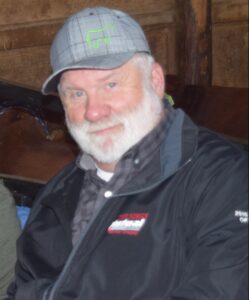
After years of looking, Brian Trueman finally found a simple, and relatively inexpensive round bale shredder that helps reduce feed waste, improves bedding efficiency, and saves him the time and labour of trying to pull round bales apart by hand or with a fork.
The roughly 70-inch wide shredder platform that easily mounts onto the arms of the front end loader on his 95 horsepower tractor, has three auger type bars or cylinders across the width of the platform and each cylinder has between 18 to 22 sickle teeth. (The cylinders, which are spaced about 20 inches apart look a bit like sections of a 6-inch grain auger.) The shredder mounted on the front-end loader arms has two 47-inch long forks on the front edge. Slide those forks under a conventional 1,200 to 1,500 pound round bale, tip the forks up so the bale rolls back and is basically cradled against the teeth of the cylinder bars, activate the hydraulically driven cylinders and they begin spinning and the teeth along the cylinders begin cutting away at the bale. The bale is cut so that roughly six to eight inch lengths of hay (or straw) pour out of the bottom of the shredder. As the bale tumbles and rolls against the cutting teeth, the cylinders can quickly be reversed to cut forwards and backwards on the bale.
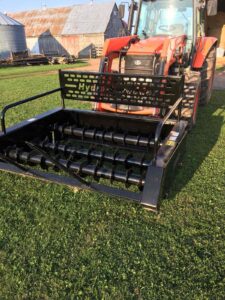
“It takes about 12 minutes to process a bale on my little tractor,” says Trueman, who along with family members runs a mixed purebred and commercial beef cattle operation near Amherst, on the northwest side of Nova Scotia near the New Brunswick border. “And I first thought that takes quite a bit of time, but then I remembered how much time I spent trying to fork apart a bale for the cows and really it is much faster and easier.”
Trueman, who runs about 80 cows, raises purebred Hereford, Angus and Simmental cattle, along with commercial cattle as well. A mixed farming operation he also produces blueberries and his wife has an apiary to produce honey. “I call it the three-B operation,” says Trueman. “Beef, blueberries and bees.”
While he had been interested in some type of shredder for years, he evaluated this Hydra-Shredder Bale Processor made in Minnesota as part of a Nova Scotia government Advancing Innovative Technologies program. The program provides partial funding to farmers to use and evaluate new technologies and report on their findings. Trueman says in his evaluation, he gave the shredder two thumbs up.

He overwinters cattle in or near two separate structures. One is a tarp-covered barn where cows walk up to a cable that runs the length of the feed alley — they reach their heads under the cable to grab feed. He also has a pole-barn where a group of cattle can access shredded bales in an outside feeder — they can reach their heads through slant bars on the perimeter of a large rectangular feeder. He feeds round bale silage, stored in long plastic silage tubes. The silage is a mix of grass/legume forages.
“I was looking for something that would help reduce feed waste,” he says. “You manage to tear apart or somehow unroll a large round bale in front of your cows, and they often grab big chunks and pull it out of the feeder. They eat most of it but also a fair amount falls down by their feet and gets trampled into the manure.”
After a season of use, he says the bale shredder has virtually eliminated the waste problem. “The shredder cuts the hay into roughly six to eight inch lengths and it is very easy for a cow to grab a mouthful without dragging a big chunk onto the ground,” he says. “I can’t say that I fed less hay with the shredder but what I did feed went where it was supposed to and that was inside the animal.”
Trueman says the shredder does improve bedding efficiency — makes better use of straw. He keeps the open area behind the cows in the tarp barn, as well as those in the pole-barn well bedded with straw. “Before I got the shredder, I’d bring in a large round bale of straw and you try to pull it apart as best as you could but there would be thick and thin layers in different parts of the bedding area.
“I put the straw bales in this shredder and it just lays out a nice even layer of bedding over the whole area,” he says. “I’m sure with the straw I used about half as much as I normally would and did a better job — straw bales cost money too.”
Trueman says the shredder scored high in achieving all objectives. It dramatically reduced the amount of wasted feed, reduced the amount of straw needed to properly bed the herd, and ultimately saved considerable time and labour compared to trying to pull bales apart.
“It is a very simple machine, that’s well built and works well,” he says. “It costs about $10,000 but then you have to consider the time and labour saved along with improved feeding efficiency. It’s also a piece of equipment that’s going to last several years.”
Larry Wegner
Virden, MB
Effective forage management doubles production
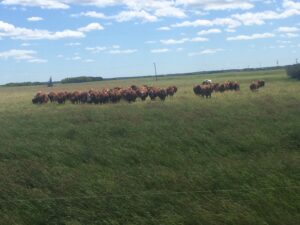
A different approach to pasture management that’s been evolving on Larry Wegner’s ranch in southern Manitoba for more than a decade has allowed him to double carrying capacity with beef cattle numbers on the same land base, has improved soil health, encouraged plant diversity with no added inputs, and as far he knows he’s not done yet.
Wegner, who farms with family members at Virden, in southwest Manitoba near the Saskatchewan border, adopted what’s known as an adaptive pasture management system on his cow-calf and yearling operation about 11 years ago.
The 800-acre farm is divided into 22 paddocks ranging in size from 15 to 80 acres. Grazing season runs from early April, with cattle turned out onto stockpiled forage (new grass coming underneath) around April 10, and runs until early December. Under his previous, more extensive grazing system, the ranch supported about 100 head of cow-calf pairs for the season. In 2018 he grazed the same area with 250 cow-calf pairs, in a flexible grazing system that still left 50 per cent of the forage in the pasture.
“I’m not sure if we’ve reached the maximum yet or not,” says Wegner. “I’m still learning. I believe there is still some upside to be had, but it is obvious with proper management the land has become more productive.”
The “adaptive” management aspect of the system is that he moves cattle as the forage dictates — be adaptive, be flexible. “When I move cattle depends on the growing conditions, the number of cattle, and the size of pasture,” says Wegner. “But my general guideline is to move when cattle have removed 50 per cent of forage and not come back to that same paddock for at least 60 days, allowing time for regrowth. So with all factors considered I might move cattle three times a day or I might move once every three days.” Depending on the growing season and circumstance he might move cattle when they’ve only removed 30 per cent of forage and the odd time they may stay longer to remove 75 per cent of forage. “The important part is to leave sufficient recovery time for forages to regrow before you graze it again,” he says.
Plant diversity is one of the indicators that the system is working. About half of the Wegner farm was at one time mostly tame grass species and about half was native range. But over the years of following the grazing system he has seen plant species numbers increase and spread. “The last inventory that was done there was 98 different species of native forages growing on pastures along with some of the tame grass species,” he says. He hasn’t renewed any pastures with seeding or fertilizer. Pastures are managed to periodically mature and set enough seed to re-establish themselves. He has also seen that cattle will distribute the seed of some tame species like birdsfoot trefoil in their manure to new areas of the farm where the species wasn’t seen before.
“Plant diversity is the key and with a rest/rotation system the plants are able to set seed to repopulate themselves and also develop root systems to open up the soil,” he says. With root systems and earthworm activity in the soil he’s seen a dramatic improvement in water infiltration capacity — an inch of rain, for example, will disappear into the soil in less than a minute. “The water holding capacity of the soil has increased so even during a dry period there is still moisture available to keep the grass growing,” says Wegner.
With cattle on pasture until December, he plans on a 120-day winter-feeding period. He uses a bale grazing system, placing hay out on pasture so all manure stays in the pasture.
“When I tell people I sometimes move cattle three times a day, their first reaction is that it is a lot of work,” he says. “But in reality once cattle are used to being moved it takes about 15 minutes to open the gate and really they move themselves. And at the same time it gives me a chance to look at the cattle to see how they are doing.”
Related:
- Eight beef producers share their recent changes (BCRC Blog post)
- It can pay exponentially to have a precision rancher mindset (BCRC Blog post)
Click here to subscribe to the BCRC Blog and receive email notifications when new content is posted.
The sharing or reprinting of BCRC Blog articles is welcome and encouraged. Please provide acknowledgement to the Beef Cattle Research Council, list the website address, www.BeefResearch.ca, and let us know you chose to share the article by emailing us at info@beefresearch.ca.
We welcome your questions, comments and suggestions. Contact us directly or generate public discussion by posting your thoughts below.
